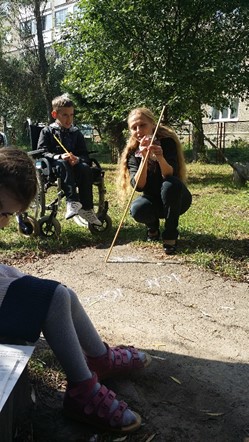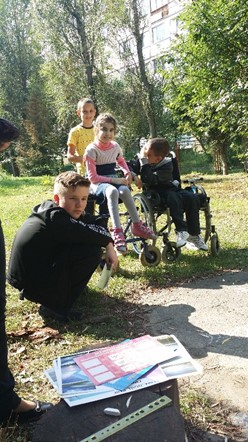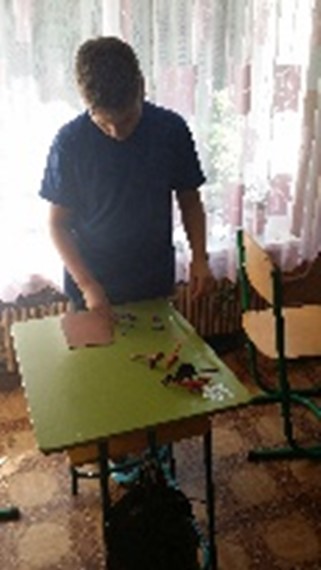They don’t call them students here, they call them pupils. And they are pretty darned wonderful. There are 110 kids at the school, ranging in age from 5-17. The very youngest are in kindergarten, which here is a combination of the US pre-school and kindergarten. The oldest are in ’12th forms’, which is our equivalent of senior year (12th grade). The classes are small – I haven’t seen more than 8 in any since classroom at one time. They do occasionally combine classrooms for some activities, but generally it’s the same grade-based divisions we have at home. The school is specifically designed for students with physical disabilities (those with sensory disabilities attend school elsewhere). However, there are many students with multiple disabilities which primarily seem to impact development and (to some extent) cognition. From what I could gather initially though, most seem to have strong intellectual skills and in the United States would be fully included in a regular classroom.
The pupils follow a general education curriculum and I’m pleased to see that they aren’t babied in any way. The teachers at the school all try to maintain high standards and push the kids (in a positive way) to meet them. For example, it was a nice day out and so the 5th form class (I think), went outside for their math lesson. They were learning how to calculate the angle of the sun using a stick and a protractor.


I kept thinking of the show “Are you smarter than a 5th grader?”
My answer would be a definitive No.
All of the pupils, except for those who are nonverbal (or really, really little) are learning English. It’s part of a new national curriculum in Ukraine. They see English as the primary language used in the West and recognize that it offers greater opportunities for Ukrainian youth to interact more globally. So I was pleasantly surprised as I visited each classroom to hear the students shyly saying “Good Morning Katie” in English…and then giggle wildly when I said “Good Morning” back to them.
Katie? Yeah, about that. Ukrainian and English are both difficult languages to learn and they are very different from each other. First, there’s the alphabet. We share some letters but they aren’t usually pronounced the same (For example, our letter “P” in Ukrainian is pronounced like “R” in English and the letter “B” in English is a “V” in Ukrainian). Also, letter combinations are different. There is no “th” sound in Ukrainian…. And the “thl” combo in my name is as hard for them as the “djy” is for me. So they all decided that they would call me Kate or Katie instead (and occasionally Katya). I don’t mind – as long as I know what to respond to, I’m flexible.
The children have been very welcoming in general and I’m working hard to establish a comfort level so that they can just be themselves when I’m around. It’s hard for me to observe them when they’re on their best behavior. So I’ve been playing little games with them in the hallways between classes and waving at them all the time. And even when I say ‘goodbye’ to them in Ukrainian, they will respond in English. They especially like to do this when their parents come to pick them up from school… I can see how proud they are of their skills. My colleague Zinna told me on Friday that verdict from the kids is that I’m fun. She said ‘You know how I learned this? The children go home and talk about you to their parents, and the parents tell me EVERYTHING.” I laughed and said “Surely not everything” and without batting an eye she said “They say you make silly faces at them when the other teachers aren’t looking and you pretend to chase them in the hallways”. Busted!
The kids can’t say more than the basic “Hello, my name is ____ and I am from Ternopil” in English….which is about my level of Ukrainian right now. But kids always find a way to communicate. For example, this boy Sasha clearly has ADHD and has a hard time focusing on his school work. He also seems to have some sort of language processing issue going on. So his teacher gets him to focus on school work for 10-15 min at a time and then he’s allowed to spend a few minutes making dinosaurs out of clay. Any they’re pretty good! When I visited his class, he immediately dragged me over to his sculpting table and started explaining the differences between each one – pantomiming when I didn’t understand. It didn’t seem to slow him down one bit that we couldn’t speak a common language. Not one bit.


Kids always find a way.
 The kindergarten class was hilarious – the little kids are really just learning to socialize and the poor teacher had her hands full. When I walked in, those who could ambulate on their own immediately ran up to me and wrapped their arms around my legs in a hug. Even those in wheelchairs were pushing to get close enough to touch me. When they all wrapped themselves around me at once, I felt like I was being licked by kittens….only stickier.
The kindergarten class was hilarious – the little kids are really just learning to socialize and the poor teacher had her hands full. When I walked in, those who could ambulate on their own immediately ran up to me and wrapped their arms around my legs in a hug. Even those in wheelchairs were pushing to get close enough to touch me. When they all wrapped themselves around me at once, I felt like I was being licked by kittens….only stickier.
The older students are bright and motivated and most really do seem to want to learn. They are studying physics and chemistry and math and world history… and of course they are typical teenagers at times as well. We were touring the dorm rooms and I asked if the children were learning independent living skills like how to make their own beds and use an alarm clock to get up, etc. And the lovely Vera said “Oh yes, the young ones are very proud of their work. But the older ones….” And then she sighed and picked up an apple core from one of the beds.
I am still trying to sort out what options the pupils will have once they leave this school. They seem to have many talents but I also know the social attitude here is  very negative around disability and for the most part, they wouldn’t be given an opportunity to attend a university or get a job. It is a sensitive subject and since it was just my first week, I didn’t want to push the issue too much. But just look at this artwork for example. This sculpture is about one meter in height and is made completely out of matchsticks. It’s just amazing work and particularly so when you see the guy who made it. He’s in his final year of school and is talented in so many different ways – academically, artistically, linguistically…. I really hope he’s able to put those skills to good use. He loves architecture and can draw nearly anything he sees. And sometimes he draws buildings only he can see in his mind. They are absolutely stunning.
very negative around disability and for the most part, they wouldn’t be given an opportunity to attend a university or get a job. It is a sensitive subject and since it was just my first week, I didn’t want to push the issue too much. But just look at this artwork for example. This sculpture is about one meter in height and is made completely out of matchsticks. It’s just amazing work and particularly so when you see the guy who made it. He’s in his final year of school and is talented in so many different ways – academically, artistically, linguistically…. I really hope he’s able to put those skills to good use. He loves architecture and can draw nearly anything he sees. And sometimes he draws buildings only he can see in his mind. They are absolutely stunning.
Is it really possible that he might sit at home after graduation and do nothing with his life?
I’m not naïve enough to think that I’m going to change the attitude of an entire country overnight, but I really want this one boy to have a chance.
Okay, I want the ALL to have a chance.

Kathleen- what an awesome blog! So interesting & exciting! I can’t wait to hear more about your work! I hope all is well.
Cherie
Thanks Cherie! I hope is all well with you too. Let’s find a time to connect via email or Skype and talk about your plans for sabbatical.